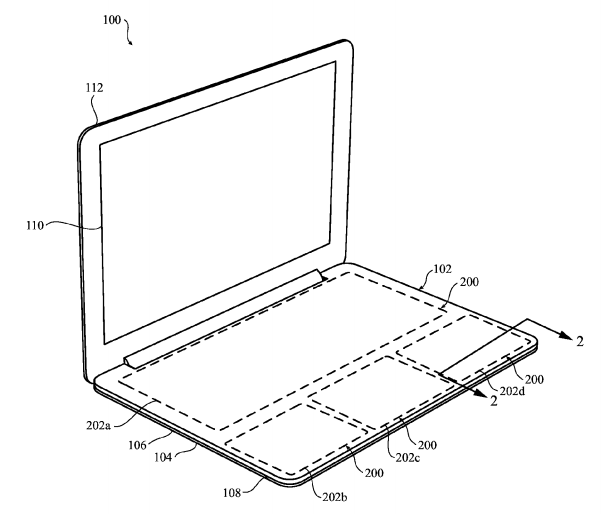Will Zero-Travel Virtual Keys Be The Next Phase In Apple’s Laptop Keyboard Evolution? – The ‘Book Mystique
Last week Apple was granted a patent for a “configurable, force-sensitive input structure for an electronic device,” which in plainer English is a capacitive keyboard that could be used in laptop computers instead of the traditional physical keyswitch type keyboard. Essentially, it would bring tablet-style virtual keyboard input to laptops, with the addition of haptic “motion” feedback even though the user would be striking zero-travel “keys” on a flat plane.
Advantages of such a setup would include enabling iOS style custom keyboard layouts that could change for optimization with the application in use, a drastic reduction in moving parts and elimination of the mechanical wear factor and increased resistance to dirt and/or moisture ingress. The abstract published with United States Patent Application 20160098107 notes that because conventional laptop keyboards typically have components positioned both inside and outside the device enclosure, such as keycaps protruding from the housing, corresponding internal dome switches and electrical contacts and traces located inside the enclosure, they are susceptible to damage from debris and other contaminants that may enter the device enclosure through keycap apertures, and potentially damaging internal components. Moreover, if a single component is damaged, lost, or quits working, the entire input device may become inoperable. Likewise, mechanical input device components may be especially vulnerable to a drop or mechanical shock.
Other benefits of capacitive touch input keyboards in laptops would be presumed lower-cost, and with Apple’s thin device obsession — potential for even slimmer laptops than the current 12-inch MacBook.
I’m a big fan of using the virtual keyboard in my iPad, although on a 9.7-inch panel in landscape mode you do lose half or more of the screen’s depth to accomodate the keyboard. That would not be an issue with a capacitive ‘zero-travel’ keyboard located on the lower plane of a clamshell laptop form factor. Consequently, this is a concept that I think I could happily embrace, and I hope Apple will proceed with it, although I expect a sizeable faction will beg to differ.
Keyboard characteristics preference is highly idiosyncratic, and capacitive keyboards have many detractors, particularly among touch typists, whom haptic feedback might help to win over.
Some folks, my touch typist wife for instance, prefer old-school keyboards with “clicky” mechanical keyswitches, relatively stiff key action an long key travel. Personally, I prefer quiet keys with short travel and very light and smooth action, a soft landing, and a minimum of “over-center” feel.
The evolution of keyboards used in Apple laptops has been somewhat uneven, in recent years complicated by Apple’s obsessive pursuit of form factor thinness.
The ‘boards in the original 100-series and Duo PowerBooks were OK in the context of the day, but nothing special. The 500, 5000, 3400, and original G3 series PowerBook keyboards were better, but still nothing to get up in the night and write home about. The PowerBook 1400 was an exception in that late-90s keyboard mediocrity interval, having a very nice keyboard action and feel. A major revolution came with Apple’s adoption of scissors-action keys that had been pioneered in the IBM-Japan built PowerBook 2400c subnotebook in the mid-’90s and used in the PowerBook G3 Series WallStreet, whose keyboard probably has my vote as best Apple laptop ‘board ever, although the subsequent G3 Series Lombard and Pismo PowerBook families had superb scissors-action keyboards as well.
For some reason, I never found the keyboards in the titanium and aluminum PowerBook G4 models as comfortable as the G3 Series ‘boards, even though they used similar technology, and I disliked the keyboard in my white 2003 iBook, which may have been Apple’s worst-ever laptop ‘board.
I’ve gotten used to the so-called “chiclet” keyboards introduced with the aluminum unibody MacBooks and MacBook Pros in 2008, which are not bad but nothing to rave about. I find their action stiffer and with more “over-center” than I prefer.
Consequently, the prospect of capacitive, zero-travel laptop keyboards appeals to me — a least theoretically. It would be necessary to live with one for a while in order to determine whether it would be an improvement over the status quo. I hope we get the opportunity.

